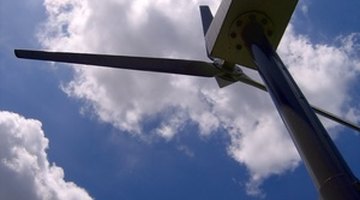How to Use a Three Phase Induction Motor as a Generator
Three-phase induction motors are plentiful and relatively inexpensive new or used because of their extensive implementation throughout industry. There are several methods for using them as generators, which vary greatly in complexity and advisability for the do-it-yourselfer. The best practical approach is to wire it as you would for a normal motor application, and then to over-run it while it is operating--with an engine, windmill, or turbine to reverse current flow and push power back into the grid. This practice effectively slows the demand meter.

Step 1

Note the three-phase induction motor's nameplate information including voltage, horsepower rating, and rpm (revolutions per minute). This information will help you correctly match the motor to an external engine or power source that will allow the motor to operate as a generator.
Step 2
Connect the motor's L1, L2, and L3 (and the ground terminal leads) to the three 208-volt, three-phase power leads and ground, just as if it were a motor application. Use a hard-contact three-phase motor switch besides the main breaker that will allow you to disconnect the motor from the utility power if necessary.
Step 3
Divide the gasoline engine's normal speed in rpm by the motor's stated rpm. Most gasoline engines (power-equipment type) run at 3600 rpm. If the induction motor turns at 3600 rpm, the ratio is 1:1, so use the same pitch-diameter pulleys on both the gasoline engine and the three-phase motor to transmit the driving force to the motor. This will allow the gasoline engine to just slightly overdrive the motor to actually produce electricity. If the three-phase motor is rated at 1800 rpm, you must halve the size of pulley on the engine, so that it can drive the slower motor within its 1800-rpm range.
Step 4
Mount the engine in-line with the motor on a solid base in the right direction so they rotate together according to the motor's required rotation direction. Also install an engagement-idler pulley to allow the engine and motor to be disengaged for start-up purposes.
Step 5
Start the gasoline engine. Turn on the three-phase induction motor at its start switch. After warm-up, adjust the gasoline engine to full speed, where its governor will hold 3600 rpm. Engage the drive belt with the engagement idler-pulley lever. Slightly increase the gasoline engine to about 3650 rpm, at which point the motor will produce electricity instead of consuming it. This will cause the demand power meter in the facility to slow down, as the three-phase power will actually flow to other motorized power users in the facility. The power company sees this situation as if less equipment is running in the facility.
A bonus feature of the induction motor in this application is that it intrinsically stays precisely in phase with the 60-cycle-per-second cadence set by the power company.
References
Resources
Writer Bio
Pauline Gill is a retired teacher with more than 25 years of experience teaching English to high school students. She holds a bachelor's degree in language arts and a Master of Education degree. Gill is also an award-winning fiction author.
Photo Credits
- windmill generator image by Yali Shi from Fotolia.com
- motors image by Dusan Radivojevic from Fotolia.com
More Articles



